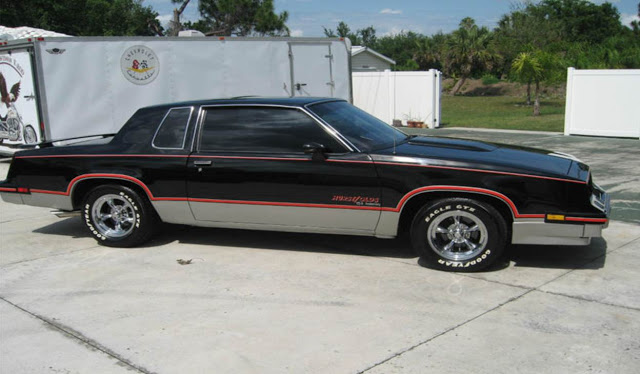The shifter alone is cool enough to warrant a look, but we always liked these Hurst Olds. They definitely have a menacing look, similar in some ways to the Grand National built on the same GN G-Body architecture.
Unfortunately, these V8s weren’t all that great at the time and Olds never pursued Buick’s turbocharging strategy in its G-body; so this 307-equipped beauty doesn’t even come close, especially considering later GNs. So, it’s likely slow by today’s standards, but should offer good low-end torque and V8 rumble.
The seller makes no mention of the custom wheels nor any other mods. Price seems high to us…
Click for eBay ad
Port Charlotte, FL
$14,900 BIN/OBO
05/14/2013 update: SOLD for $14,900
This is pretty awesome in a 1980s muscle car revival kind of way.
Ad text:
A great opportunity to own a real Hurst/Olds. Only 75000 miles, custom wheels and original wheels.
The mid-Eighties were strange times for performance car fans. The glory days of the muscle car era were only about 15 years earlier, but when they ended, an entirely new mentality overtook the public consciousness. A little more than a decade later, the good old days might well have been ancient history, as cars changed profoundly and fundamentally.
Front-wheel drive, fuel injection, and ads that touted miles per gallon rather than miles per hour were the norm in the 1980s. The few models that had performance intents were next-generation cars with McPherson strut suspensions, turbochargers, and dashboards that looked like circuit boards. Then there was the 1983 Hurst/Olds.
A model designed to commemorate the 15th anniversary of the original, 1968 model, the “new” Hurst/Olds was really a 15-year-later example of classic Sixties architecture: body-on-frame construction (GM’s venerable G-body), control-arm front suspension, and a V-8 engine driving a live rear axle. There was no space-age styling or monochromatic trim. The Cutlass-based Hurst/Olds was boxy and ringed with chrome.
Only 3,001 examples were built (201 sold in Canada), all of them black with a silver lower body and red dividing stripe. Special badges, door graphics, a rear spoiler, and styled steel wheels were part of the striking exterior package. All of the cars came off Olds’ assembly line in Lansing, MI, and then shipped about 45 miles away to secondary manufacturer Cars and Concepts, which changed each Cutlass into a Hurst model. Each carried the order code W-40. A power moonroof was offered.
Performance-wise, every Hurst/Olds packed a four-barrel-fed, 307-cube engine with 180 horsepower, a Hydra-Matic 200-4R overdrive transmission, and a 3.73 rear axle. Along with its 180 horses was a solid 245 lb-ft of torque. It was a combination good for 16-second quarter-miles and 0-60 sprints of about nine seconds.
The performance may not have set the dragstrip on fire, but the Hurst Lightning Rod shifter system gave the car a unique, signature feature that looked wild and worked quite well. Essentially a mechanical version of the electronically controlled, manual-shift automatics used in many cars today, the Lightning Rod shifter enabled the driver to use a separate shifter for each upshift. The shifter has proven very robust over the years.
After a successful run in 1983, the Hurst/Olds returned in 1984 with a silver-over-black paint scheme that was essentially a reversal of the first-year model. The only real product difference was the change to a larger, 8.5-inch rear axle. Production increased to 3,500 units.
From a desirability standpoint, the slightly lower production and more striking paint scheme gives the 1983 models the nod. The silver 1984 cars have all the goods and look strong, but it’s hard to beat the all-business aesthetic of the black 1983 models. They just look like special-edition performance cars.
When shopping for a Hurst/Olds, ask first and foremost if the paint is original–even on low-mileage examples. The factory lacquer paint jobs were notorious for not holding up well, and many of the cars–especially the black ones–have been repainted either partially or completely. This car has a complete new paint with decals.
SPECIFICATIONS
Number Built – 3001 (1983), 3500 (1984)
Construction – Body-on-frame
Engine – 307 cubic-inch V-8
Power/Torque – 180 horsepower, 245 lb-ft torque
Transmission – Hydra-Matic 200-4R four-speed automatic
Suspension front – Independent, unequal control arms with shocks and coil springs, stabilizer bar
Suspension rear – Live axle with four trailing arms; shocks, coil springs, and stabilizer bar
Brakes – Front disc/rear drum
Length/width/height – 200/71.6/54.9 inches
Wheelbase – 108.1 inches
Weight – 3,557 lbs.
0-60/quarter mile – 9.1 seconds, 16.6 seconds at 83 mph (Car and Driver, July 1985*) (1985 Olds 442 equipped with the same powertrain)
Top speed – 113 mph (Car and Driver, July 1985*)
MPG – 15 – 22 est.
STRONG POINTS
Classic good looks (especially 1983 models)
Small-block V-8 torque feels robust
Distinctive Lightning Rod shifter looked and worked great
One of the few true collectibles from the 1980s
Drivers side seat hinge cover cracked but I should have one by the time it sells. You can call Mark at 941-xxx-xxxx




